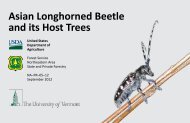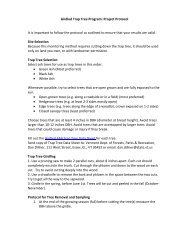WILD CHERVIL - Vermont Invasives
WILD CHERVIL - Vermont Invasives
WILD CHERVIL - Vermont Invasives
You also want an ePaper? Increase the reach of your titles
YUMPU automatically turns print PDFs into web optimized ePapers that Google loves.
<strong>WILD</strong> <strong>CHERVIL</strong><br />
invasive<br />
fact sheet<br />
Wild chervil invades<br />
<strong>Vermont</strong>’s fields and<br />
forests. It is easy to see<br />
in May and June when<br />
its white flowers are in<br />
bloom.<br />
© Victoria Weber<br />
fern-like<br />
leaf<br />
© Leslie Mehrhoff/IPANE<br />
wild chervil<br />
white,<br />
delicate<br />
flowers<br />
© Victoria Weber<br />
green plant,<br />
without flowers<br />
© Victoria Weber<br />
♦<br />
♦<br />
♦<br />
♦<br />
The Problem<br />
Wild chervil (Anthriscus sylvestris) spreads<br />
quickly. Seeds are dispersed by wind,<br />
mowers and animals. Plants also reproduce<br />
vegetatively by producing 5-10<br />
crowns per plant.<br />
Chervil replaces native grasses and wildflowers.<br />
Hayfields can be destroyed by chervil. It<br />
produces poor quality forage and hay for<br />
grazing animals.<br />
It probably arrived in New England as a<br />
component of British wildflower seed<br />
mixes which were used to recreate the<br />
floral meadows of Britain. Wild chervil<br />
may still be found in some wildflower<br />
seed packets and buyers should make<br />
sure they have a complete list of plants<br />
within generic mixes that they are purchasing.<br />
The Nature Conservancy, Montpelier, <strong>Vermont</strong><br />
802-229-4425 x120<br />
www.vtinvasives.org
<strong>WILD</strong> <strong>CHERVIL</strong><br />
For new infestations:<br />
New infestations should be treated rapidly before an extensive<br />
root system is established. Hand pull or dig up plants to<br />
ensure the entire tap root is removed. Check the site the<br />
next year for new growth.<br />
For large infestations:<br />
Mowing large patches of chervil will prevent it from setting<br />
seed. Do not mow after June, when the plant has already set<br />
its seeds. Clean all equipment well before using again. If<br />
possible, after mowing, cover ground with thick plastic or<br />
other ground cover.<br />
THIS PLANT IS DIFFICULT<br />
TO MANAGE<br />
The best solution is to avoid the<br />
problem plant getting established in<br />
the first place. There is no known<br />
eradication method once it has been<br />
established. Be diligent and remove<br />
plants early on in their infestation.<br />
CAUTION! This plant contains toxins that cause minor skin irritation.<br />
Wear appropriate clothing to prevent resinous substances from contacting skin.<br />
Integrated Invasive Plant Management<br />
Most landowners have more than one invasive plant species on their property. Before you head for the clippers, develop a management plan. A welldeveloped<br />
plan that is specific to your property will help you save time and money, increase long-term effectiveness and reduce the spread of invasives.<br />
√ Create land management goals. Determine what natural features you are most interested in protecting and what wildlife<br />
management, forestry activities<br />
non-invasive<br />
or trail building<br />
alternatives<br />
goals you have for the next five to 20 years, and what you want the<br />
land to be like in 200 years.<br />
√ Map the invasive species on your property and the surrounding area. Look for invasive plants along logging roads and trails,<br />
and other openings in the forest canopy. Roughly map the species that you find, and convey a sense of the size and<br />
density of the populations.<br />
√<br />
Practice Early Detection and Rapid Response (EDRR). Each year, walk your entire property. Look for and remove new<br />
occurrences of invasive species. Stay up to date on what invasive species are coming into your area.<br />
√<br />
Consider available resources and develop a timeline. Be realistic with the time and money you have and set goals accordingly.<br />
Based on what resources you have available, time your work accordingly.<br />
√<br />
Determine a weed- or site-led management approach. Site-led management is designed for the landowner interested in protecting<br />
a particular resource or natural feature from encroachment. Weed-led management approaches the problem from a<br />
single-species perspective. Your approach may change from one part of your property to another, depending upon<br />
the species present, natural features, vegetation types and land management goals.<br />
√<br />
Integrate invasive species prevention and management into all of your land management activities. Certain land management<br />
activities may spread invasive species. Predict what activities (e.g. logging, construction of trails, roads or buildings)<br />
will cause future problems and take necessary precautions. For example, after spending time in an area that has invasive<br />
plants, check clothing for seeds and remove soil from shoe soles. Require that any logging, mowing, or excavation<br />
equipment that comes on your property is weed-free. Monitor new plantings, whether within designed landscapes<br />
or natural settings, for invasives that may have been present in imported soil. Before doing a cut in a timber<br />
stand, remove all invasives. Ask your forester to incorporate invasive plant management into your land management<br />
plan.<br />
The Nature Conservancy, Montpelier, <strong>Vermont</strong><br />
802-229-4425 x120<br />
www.vtinvasives.org














